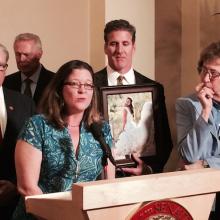Brittany Maynard

Image via Compassion & Choices / RNS
California Gov. Jerry Brown has until midnight Oct. 7 to sign or veto a controversial bill that would legalize physician-assisted dying in the nation’s most populous state.
Both supporters of the bill, who say it fosters “death with dignity,” and opponents, who call it legalized suicide, urge calls to the governor’s office and prayers to the Almighty while they wait out the clock.
And both sides expect this decision is a tough call for Brown.

Brittany Maynard, who was diagnosed with brain cancer at 29, moved from California to Oregon, where physician assisted suicide is legal, dying there because California forbids the practice. Photo via Mariano Cuajao / Flickr / RNS
The California “End of Life Options Act,” otherwise known as SB 128 or “right to die,” was pulled from an state’s Assembly Committee on Health hearing July 7 after the bill’s lead authors say they need more time to convince colleagues who are struggling with the decision and may hold it until next year.
The bill would provide terminally ill and mentally competent patients who’ve exhausted all medical options to obtain a prescription for lethal medication, provided that two physicians sign off. Patients would need to affirm the request after a 15-day waiting period.
More than a dozen states, plus the District of Columbia, are considering controversial medically assisted death legislation this year.
The laws would allow mentally fit, terminally ill patients age 18 and older, whose doctors say they have six months or less to live, to request lethal drugs.
Oregon was the first state to implement its Death with Dignity Act in 1997 after voters approved the law in 1994, and four other states — Montana, New Mexico, Vermont, and Washington — now allow for medically assisted death.
As of April 10, at least another 25 states have considered death with dignity bills, according to Compassion & Choices, a Denver-based nonprofit organization that advocates for these laws. Some of those bills already have died in committee.
“The movement has reached a threshold where it is unstoppable,” said President Barbara Coombs of Compassion & Choices, who was also chief petitioner for the Oregon Death with Dignity Act.
The issue of medically assisted death rose to prominence last year with the case of Brittany Maynard, 29, who was told she had six months to live after being diagnosed with brain cancer. Maynard was a strong advocate for Death with Dignity, and when she learned of her grim prognosis, she moved from her home state of California to Oregon where terminally ill patients are allowed to end their own lives.
“I would not tell anyone else that he or she should choose death with dignity,” she wrote in an op-ed on CNN.com.
“My question is: Who has the right to tell me that I don’t deserve this choice? That I deserve to suffer for weeks or months in tremendous amounts of physical and emotional pain? Why should anyone have the right to make that choice for me?”
Brittany Maynard chose to die Nov. 1, but on what would have been her 30th birthday Nov. 19, her voice in support of the Right to Die movement rang loud.
Maynard, who had an aggressive brain tumor, was the face of Compassion & Choices, the advocacy group campaigning to legalize physician-assisted dying in all 50 states. She still is.
On her birthday, the group released a “call to action” video with passages and narration drawn from prerecorded videos with Maynard (pronounced MayNARD) and other advocates explaining why the right to die by legal prescription is important to them. It is now legal in Oregon, Washington, Montana, Vermont, and New Mexico.
In the video, Maynard concludes: “If there’s one message to come away from everything that I’ve been through, it is no matter what life kind of presents you with, is never be afraid to use your own voice. And even if you are uncertain, even if your voice is shaking, ask the questions you want to ask, speak up for yourself. Advocate.”
Death never makes for easy conversation. But the choice of a 29-year-old Brittany Maynard to take her own life over the weekend has a lot of people talking. There are the sad and belligerent comments in the name of Christianity, as well as those from supporters of her decision and still others who seek to be empathetic but strongly disagree.
Nearly five years ago, I was laying in an ICU, on oxygen, catheterized, wearing a diaper, and on a constant flow of the most potent narcotics the hospital had available. I could not eat, drink, or even hold an ice cube in my mouth and was unable to get out of bed under my own power. Much of my family had gathered in the room to hear the doctor pronounce that there was nothing more they could do.
My situation was not the same as Brittany’s or any others’ with terminal cancer, but this experience left me with a heightened awareness of some areas where Christians need to do better when faced with death and pain. It’s beyond the scope of this post to lay out all of the theological and moral implications involved, let alone all of the political and legal implications, but here are four areas for thought.
The Vatican’s top ethicist condemned Brittany Maynard’s decision to end her life, saying there was no dignity in her physician-assisted death.
Maynard, 29, took a lethal prescription provided by a doctor under Oregon’s death-with-dignity law. She died in her bed Nov. 1 after leaving family and friends a final farewell message. Earlier this year, she was diagnosed with an inoperable brain tumor and given only months to live.
“We don’t judge people, but the gesture in itself is to be condemned,” said Monsignor Ignacio Carrasco de Paula, head of the Pontifical Academy for Life, which is responsible for ethical issues in the Catholic Church.
“Assisted suicide is an absurdity,” Carrasco de Paula told the Italian news agency ANSA. “Dignity is something different than putting an end to your own life.”
Maynard became a media sensation as a video she posted on YouTube was viewed 9.8 million times. Her death made her an appealing young face for the right-to-die movement.
Brittany Maynard, the 29-year-old suffering with an aggressive brain tumor, died Nov. 1— as she said she would.
Sean Crowley, spokesman for the non-profit advocacy organization Compassion & Choices, confirmed Maynard’s death Nov. 2.
“She died peacefully on Nov. 1 in her Portland home, surrounded by family and friends,” according to a statement from Compassion & Choices, which first publicized Maynard’s controversial plan to take control of her death.
The statement said Maynard suffered “increasingly frequent and longer seizures, severe head and neck pain, and stroke-like symptoms.” She chose to take the “aid-in-dying medication she received months ago.”
She captivated millions via social media by announcing her plan to end her life around Nov. 1 by taking a lethal prescription provided to her by a doctor under Oregon’s death-with-dignity law.
Brittany Maynard’s decision to die soon by a legal, lethal prescription, rather than let a brain tumor kill her, has provoked a national conversation and debate about end-of-life decisions.
In a new video, released Oct. 29, she says she feels herself getting sicker by the day. But since she still feels joy in living, she’ll postpone her day of death past the date originally announced — Nov. 1.
Maynard, 29, has inspired raging arguments about the values, even about the vocabulary, underlying the choices we make about our last days. Her goal, she still says, is to “influence this policy (on physician-assisted dying) for positive change.”
As ethicists, activists and religious voices square off, here are five things to know about death and dying.





